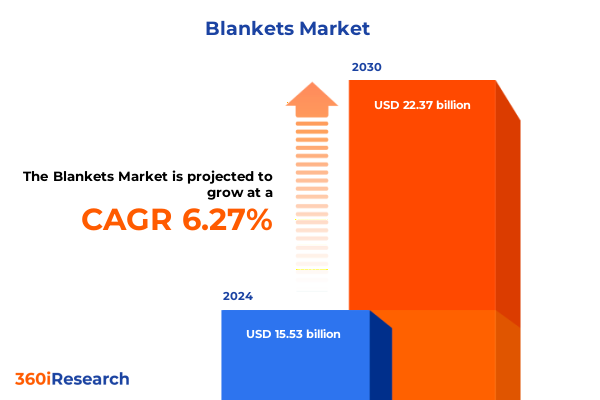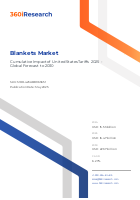The Blankets Market size was estimated at USD 15.53 billion in 2024 and expected to reach USD 16.47 billion in 2025, at a CAGR 6.27% to reach USD 22.37 billion by 2030.

Introduction to the Evolving Global Blanket Industry
The blanket industry has undergone significant transformation as consumer expectations evolve, supply chains adapt, and sustainability becomes a core value proposition. In response to shifting climate patterns, rising disposable income, and heightened focus on wellness, manufacturers and retailers are innovating product portfolios to strike the right balance between comfort, performance, and aesthetic appeal. This executive summary provides a comprehensive overview of the current marketplace, outlining the key drivers, structural shifts, and strategic imperatives affecting stakeholders across the global blanket sector. As industry leaders refine their strategies, understanding these dynamics will be essential for capitalizing on emerging opportunities and mitigating potential threats.
Transformative Shifts Reshaping the Blanket Market
Over the past decade, the blanket landscape has been reshaped by a wave of transformative trends. First, sustainability has moved from a niche positioning to an industry standard: brands now prioritize renewable natural fibers like bamboo and linen alongside recycled synthetics. Second, technological integration in products-from temperature-regulating cooling blankets to smart thermal controls in heated designs-has elevated user experience and driven premiumization. Third, supply chain resilience has become paramount, with manufacturers diversifying sourcing strategies for natural fibers such as cashmere, wool, and alpaca, while simultaneously investing in automation to streamline production techniques. In parallel, consumer demand for personalized patterns and textures has grown, prompting the proliferation of bespoke digital-printing services for floral, geometric, plaid, and solid-color offerings. Finally, distribution channels have shifted dramatically: online retail via brand websites and e-commerce platforms now complements traditional department stores, specialty shops, and supermarkets & hypermarkets, reflecting omnichannel strategies that bridge convenience and immersive brand experiences.
Cumulative Impact of United States Tariffs 2025
As of 2025, new United States tariffs on imported textile fibers and finished home goods have exerted multifaceted pressure on the blanket sector. Raw-material costs for synthetic fibers such as acrylic, microfiber, nylon, and polyester have climbed due to levies on petrochemical feedstocks, compelling manufacturers to either absorb costs or adjust end-user pricing. Simultaneously, tariffs on natural-fiber imports, including cashmere, silk, and wool, have disrupted traditional supply chains that span from Mongolia and India to Italy and Denmark. In response, some producers have accelerated localization initiatives, forging partnerships with domestic sheep and alpaca farms, while others have pivoted toward blended-fiber constructions to hedge against single-origin risks. Distribution channels have felt these shifts as well: offline retail partners have tightened inventory cycles, prioritizing high-margin, locally sourced designs, whereas online channels are leveraging dynamic pricing engines to optimize conversion rates amid fluctuating cost structures. As a result, brands are increasingly focused on operational agility, strategic sourcing diversification, and value-added services such as custom embroidery and rapid replenishment.
Key Segmentation Insights Across Material, Pattern, Type, Size, Technique, Channel, and End Use
Material-based analysis reveals that blended fibers are gaining traction for their cost efficiency and balanced performance, while demand for natural fibers remains robust, led by cotton’s versatility and wool’s insulative properties; premium segments such as cashmere and alpaca continue to command high margins. Synthetic fibers hold appeal in active-lifestyle categories, particularly in fleece, microfiber, and polyester blends optimized for moisture-wicking and ease of care. Pattern preferences demonstrate consumer inclination toward solid-color and plaid designs for everyday use, though geometric and novelty motifs are carving out niche status among younger demographics seeking self-expression. When product forms are considered, weighted blankets are surging in wellness markets, knitted and woven constructions maintain core market share, and electric blankets are evolving with smart controls for zone-specific heating. In terms of dimensions, queen and king sizes dominate residential purchases for master bedrooms, while single and infant sizes align with children’s and nursery applications; oversized formats address lifestyle trends in communal living and outdoor leisure. Handmade blankets captivate connoisseurs who value craftsmanship, whereas machine-made offerings provide scalability and consistent quality across high-volume channels. Finally, consumer purchasing behavior is split between offline retailers-encompassing department stores, specialty stores, and supermarkets & hypermarkets-and online platforms including dedicated brand websites and large e-commerce aggregators. Commercial buyers, including airlines, hospitals, hotels, and military institutions, continue to drive bulk demand, while residential consumers fuel innovation with their appetite for design-led and performance-enhanced solutions.
This comprehensive research report categorizes the Blankets market into clearly defined segments, providing a detailed analysis of emerging trends and precise revenue forecasts to support strategic decision-making.
- Material
- Pattern
- Blanket Type
- Size
- Production Technique
- Distribution Channel
- End User
Key Regional Insights Highlighting Americas, EMEA, and Asia-Pacific
Regional dynamics are shaped by diverse consumer preferences and regulatory environments. In the Americas, focus areas include thermal efficiency for colder climates in North America and lightweight, moisture-managing designs for Latin American high-humidity zones, supported by robust departmental and specialty retail networks. The Europe, Middle East & Africa corridor is characterized by heritage woolen mills in Europe, luxury cashmere demand in the Gulf states, and growing mass-market adoption in North African urban centers; regulatory emphasis on sustainable sourcing accelerates adoption of recycled and organic fibers. In Asia-Pacific, rapid urbanization and rising disposable incomes in China and India fuel demand for premium cotton and blended-fiber blankets, while Southeast Asia’s tropical climates boost interest in cooling and moisture-wicking constructions. E-commerce growth remains exceptional across all regions but is particularly noteworthy in Asia-Pacific, where mobile-first consumers leverage digital marketplaces for direct-to-consumer purchases.
This comprehensive research report examines key regions that drive the evolution of the Blankets market, offering deep insights into regional trends, growth factors, and industry developments that are influencing market performance.
- Americas
- Asia-Pacific
- Europe, Middle East & Africa
Key Company Insights Showcasing Market Leaders and Strategic Focus
Leading players are differentiating through vertical integration, product innovation, and sustainability commitments. American Blanket Company and Berkshire Blanket & Home Co. emphasize heritage craftsmanship and broad department-store partnerships. Beurer India and Bombay Dyeing leverage domestic manufacturing to offer competitively priced, machine-made lines tailored for local climates. Chatham Manufacturing and Pendleton Woolen Mills deliver performance-focused woolens that cater to premium and wellness markets, while Cloudy India Home Furnishing and Jindal Ecotex specialize in blended-fiber thermal blankets. Coyuchi, Inc. and Ecolinen drive organic and fair-trade narratives with natural-fiber cores, and Elvang Denmark A/S and Seljak Brand champion artisanal cashmere and alpaca designs for luxury channels. Faribault Woolen Mill and GOBI Cashmere Europe underscore provenance storytelling, while Hermann Biederlack and John Cotton Group expand into smart-textile integrations. Kanata Blanket Company and Mehak Handloom Industries highlight handmade techniques, contrasted by the scalable output of Raymond Lifestyle and Welspun Living. Peacock Alley and WestPoint Home focus on lifestyle branding with digital-channel emphasis, whereas Vardhman Textiles and Welspun annex mass-market segments via supermarket and hypermarket concessions. Companies such as Wonu International and Youngman Woollen Mills are forging new export corridors, and Military-focused suppliers to the commercial segment ensure contract compliance for airlines, hospitals, and defense clients.
This comprehensive research report delivers an in-depth overview of the principal market players in the Blankets market, evaluating their market share, strategic initiatives, and competitive positioning to illuminate the factors shaping the competitive landscape.
- American Blanket Company
- Berkshire Blanket & Home Co.
- Beurer India Pvt. Ltd.
- Bombay Dyeing
- Chatham Manufacturing Company
- Cloudy India Home Furnishing
- Coyuchi, Inc.
- Ecolinen
- Elvang Denmark A/S
- Faribault Woolen Mill Co.
- GOBI Cashmere Europe GmbH
- Hermann Biederlack GmbH + Co. KG.
- Jindal Ecotex LLP
- John Cotton Group Ltd
- Kanata Blanket Company
- Mehak Handloom Industries
- Peacock Alley, Inc.
- Pendleton Woolen Mills, Inc.
- Raymond Lifestyle Limited
- Seljak Brand
- Vardhman Textiles
- Welspun Living Limited
- WestPoint Home, LLC.
- Wonu International FZCO
- Youngman Woollen Mills Private Limited.
Actionable Recommendations for Industry Leaders
Industry leaders should prioritize strategic sourcing diversification by integrating blended-fiber formulations that balance performance and cost. Investing in sustainable certification schemes, including organic, fair-trade, and recycled content standards, will resonate with environmentally conscious consumers and mitigate regulatory risks. Embracing advanced manufacturing technologies-such as automated knitting, digital-print customization, and smart-blanket thermal controls-can enhance product differentiation and drive premium pricing. Omnichannel strategies that seamlessly link brand websites with e-commerce aggregators, department stores, and specialty retailers will maximize market coverage and improve customer experience. Collaboration across the value chain-partnerships with fiber producers, logistics providers, and tech start-ups-will strengthen supply chain resilience and foster innovation. Finally, targeted B2B programs for commercial buyers in airlines, hospitality, healthcare, and defense will secure long-term contracts and stabilize revenue streams amid consumer market fluctuations.
Explore AI-driven insights for the Blankets market with ResearchAI on our online platform, providing deeper, data-backed market analysis.
Ask ResearchAI anything
World's First Innovative Al for Market Research
Conclusion on Navigating Future Opportunities in the Blanket Sector
The global blanket market stands at an inflection point defined by sustainability mandates, technological convergence, and shifting purchase behaviors. Companies that adapt to tariff-driven cost pressures through agile sourcing, embrace premium and wellness segments via smart textile solutions, and deepen regional footprint with tailored offerings will capture growth. By aligning product portfolios with evolving consumer priorities-comfort, performance, and ethical sourcing-and by leveraging omnichannel distribution frameworks, market participants can thrive in an increasingly competitive environment. Continuous investment in R&D, digital capabilities, and strategic partnerships will be critical to sustain innovation momentum and reinforce brand leadership in the years ahead.
This section provides a structured overview of the report, outlining key chapters and topics covered for easy reference in our Blankets market comprehensive research report.
- Preface
- Research Methodology
- Executive Summary
- Market Overview
- Market Dynamics
- Market Insights
- Cumulative Impact of United States Tariffs 2025
- Blankets Market, by Material
- Blankets Market, by Pattern
- Blankets Market, by Blanket Type
- Blankets Market, by Size
- Blankets Market, by Production Technique
- Blankets Market, by Distribution Channel
- Blankets Market, by End User
- Americas Blankets Market
- Asia-Pacific Blankets Market
- Europe, Middle East & Africa Blankets Market
- Competitive Landscape
- ResearchAI
- ResearchStatistics
- ResearchContacts
- ResearchArticles
- Appendix
- List of Figures [Total: 30]
- List of Tables [Total: 567 ]
Contact Ketan Rohom to Access the Full Market Research Report
To explore this comprehensive market research report and gain detailed analysis of the forces shaping the blanket industry, please reach out to Ketan Rohom, Associate Director, Sales & Marketing, to initiate your purchase and secure immediate insights.

- How big is the Blankets Market?
- What is the Blankets Market growth?
- When do I get the report?
- In what format does this report get delivered to me?
- How long has 360iResearch been around?
- What if I have a question about your reports?
- Can I share this report with my team?
- Can I use your research in my presentation?




